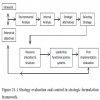IV - Semester, Global Financial Management, 1
Implications of Globalization in India
Globalization is essentially an economic phenomenon which has strong implications. To understand the effect of globalization on Indian economy, society, culture, religion and psyche, it is essential for us to know how and when economic reforms were carried out.
Implications of Globalization in India
Globalization is essentially an economic phenomenon which has
strong implications. To understand the effect of globalization on Indian
economy, society, culture, religion and psyche, it is essential for us to know
how and when economic reforms were carried out.
IMF (International Monetary Fund) has prescribed a set of rules for
the carrying out of economic reforms. When the Chandra Sekhar’s government was
defeated at the hands of Congress, Indian economy was undergoing through a
chaotic situation.
The 1991 Gulf war aggravated the international oil prices, which
seriously affected India’s BoP (Balance of Payment) situation. Exports were low
and imports were high (due to high price of oil and petroleum). India’s
economic performance was in doldrums because industrial production plunged to
the ground.
Fiscal deficit soared up to new heights, which earned nothing
except high rate of inflation. Due to the populist form of government spending
in the 1980s, supported by huge borrowings without sufficient return, India’s
internal and external debt touched the sky.
Short term commercial borrowings from abroad led to a difficult
situation for the government. India virtually came to the brink of default.
Under this situation, the Government borrowed a huge sum of conditional loan’
from IMF. Thus India became obliged to follow IMF prescribed ‘structural
reforms’.
The IMF package consists of a set of economic policies for a
debt-ridden and low performing economy, for the short run which is called
stabilization measures’, and which includes:
Monetary Policies
Positive real interest rates
Increase in reserve rate
More vigorous open market operations
Credit controls
Realignment of the Exchange
Rate to a Near Market Determined Rate.
Reduction of Budgetary
Deficits
Increased revenue mobilization efforts
Review of public investment priorities and identification of a core
programme of investment.
Real Wage Restraint
Removal of formal indexation arrangements
The Long Term ‘Structural Reforms’ prescribed by IMF include
Promotion of Private Sector
(Domestic-and Foreign)
Definitive political commitment
Rapid improvement in infrastructure
Improvement in regulatory regimes
Facilitation of investment approval procedures
Commercialization of Public
Enterprises-Improvement in Operational Efficiency
Privatization programmes
Financial Sectors Reforms
Movement to market determined rates capital market development,
including promotion of stock exchanges
Liberalization of Trade
Regime
Removal of import and exchange control and progress towards lower
and less-dispersed band of tariffs.
Price-Flexibility
Tax-Reforms
Reduction of distortion effects on resource allocation
Increased elasticity of tax-system
Administrative Reforms
Reduction in size of public service
Safety net well targeted programmes of transfers to vulnerable
groups.
Training, credit and employment programmes for vulnerable group.
Impact of Globalization on Indian Economy
Due to globalization, the export sector of the Indian economy
received a big boost. The growth performance of the exports improved during
1993-1996.
During the period April-September 2000, the export growth rate
touched the figure of 22%, while imports stood at around 15%. Thus India’s
current account situation improved due to globalization led economic reforms.
Government investment expenditure has been reduced but not fiscal
deficit which is still around 5% of GDP (Gross Domestic Product). This is
because of high consumption expenditure on the part of the government.
Government is stressing on disinvestment of public sector units.
For the employees, government has started VRS (Voluntary Retirement Scheme).
Although defense expenditure has gone up, but Government has reduced subsidies
on food, fertilizer and electricity. Social sector investment as a percentage
of GDP has not increased.
Expenditure on health and education is not substantial. Although
efforts of privatization has given an impetus to the private sector, but
employment generation by the private sector is meager.
The NDA (National Democratic Alliance) government headed by BJP
(Bharatiya Janata Party) has started the ‘second generation economic reforms’,
which includes reforms in all spheres including political institutions,
economic machinery, democratic set-up, judiciary, etc.
The proponents of globalization in India have argued that economic
integration will improve the locative efficiency of resources, reduce the
capital output ratio, and increase the labour productivity, help to develop the
export spheres and e*port culture, increase the inflow of the capital and
updated technology into













